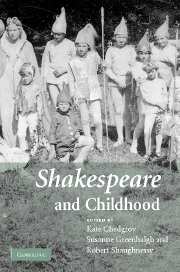Book contents
- Frontmatter
- Contents
- Acknowledgements
- Notes on contributors
- Note on the text
- 1 Introduction
- PART 1 SHAKESPEARE'S CHILDREN
- 2 Introduction: ‘What, are they children?’
- 3 Little princes: Shakespeare's royal children
- 4 Father-child identification, loss and gender in Shakespeare's plays
- 5 Character building: Shakespeare's children in context
- 6 Coriolanus and the little eyases: the boyhood of Shakespeare's hero
- 7 Procreation, child-loss and the gendering of the sonnet
- PART 2 CHILDREN'S SHAKESPEARES
- APPENDICES
- Index
2 - Introduction: ‘What, are they children?’
Published online by Cambridge University Press: 22 September 2009
- Frontmatter
- Contents
- Acknowledgements
- Notes on contributors
- Note on the text
- 1 Introduction
- PART 1 SHAKESPEARE'S CHILDREN
- 2 Introduction: ‘What, are they children?’
- 3 Little princes: Shakespeare's royal children
- 4 Father-child identification, loss and gender in Shakespeare's plays
- 5 Character building: Shakespeare's children in context
- 6 Coriolanus and the little eyases: the boyhood of Shakespeare's hero
- 7 Procreation, child-loss and the gendering of the sonnet
- PART 2 CHILDREN'S SHAKESPEARES
- APPENDICES
- Index
Summary
I begin with a child at the margin of childhood: Miranda, Prospero's daughter, barely fifteen years old, newly embarked on the transition from childhood to adulthood that for many girls in Shakespeare's works and world was enacted and marked by the ritual of marriage. Awaiting the formal solemnization of her marriage to Ferdinand, Miranda watches a wedding masque that uses music, poetry and dance to celebrate the lifechanging event ahead of her (The Tempest 4.1.60–138). Her father enjoins her (and Ferdinand) to watch the masque in silence (4.1.59), and she obeys; but tongue-tied submissiveness is not her customary mode. We already know that she can use words to give a vivid and dramatic account of an event she witnessed (1.2.1–13), to conjure up an emotional evocation of the personal past (1.2.44–7), and to express desire (3.1.53–7). She has enabled her quasi-sibling Caliban to acquire eloquent speech (1.2.354–65), and she has challenged her father's expressions of hostility to Ferdinand (1.2.477, 485–7). Declaring to Ferdinand, ‘I am your wife, if you will marry me’ (3.1.83), she has already revealed herself to be confident and subversive enough to take control of the event that initiates her formally into adulthood, embarking on an exchange that could be considered to constitute a marriage ceremony mutually and legitimately undertaken by husband and wife.
- Type
- Chapter
- Information
- Shakespeare and Childhood , pp. 15 - 31Publisher: Cambridge University PressPrint publication year: 2007
- 8
- Cited by



